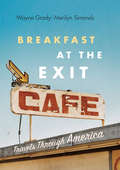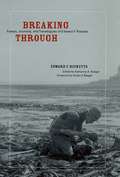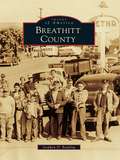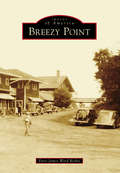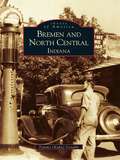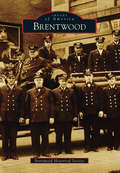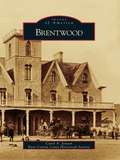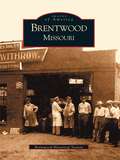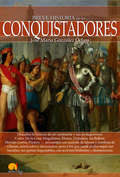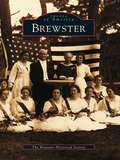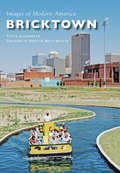- Table View
- List View
Bread and Oil: A Celebration of Majorcan Culture
by Tomás GravesA blend of history, travelogue, and cookbook focused on the Spanish island, &“with a strong sense of place [and] a genuine voice…satisfying as a fine novel&” (Terese Allen, author of The Flavor of Wisconsin). Coarse bread bathed in olive oil, then rubbed with tomato or garlic and salt, is common to all the Mediterranean cultures from France to Algeria, from Morocco to Greece. On the island of Majorca, it is known as pa amb oli, bread and oil. Tomás Graves takes this healthy peasant staple as a starting point to explore not only Mediterranean cooking, agriculture, and traditions but also the historical events that have rescued this simple dish from disappearing along with a way of life that had remained essentially unchanged since Roman times. Pa amb oli has come to symbolize for Majorcans all that is still honest and valid in the island, which became a major tourist destination in the 1960s and has been looking for its soul ever since. In Bread & Oil this wonderfully evocative writer celebrates the Majorcan character as reflected in its eating habits. He makes the sights, insights, sounds, scents, and lively folk of the Spanish island jump to life brilliantly. Whether he's writing about class structure, love, or war, Graves, in his own translation of the original Catalan version, manages to tie it all in to bread and oil. Part adventure log, part history book, part travelogue, part restaurant guide, and part cookbook, Bread & Oil includes recipes that reflect the indigenous ingredients: wrinkled olives made with olive oil, lemon juice and crushed garlic; fried sardines topped with sautéed onions and marinated in vinegar served cold with bread and oil; guacamole with tomatoes and onions; and aubergine mousse with cinnamon and curry powder. Graves, son of British poet Robert Graves, writes of a wise tip he once got: &“In the event of having had too much to drink, eat a slice of bread soaked in virgin olive oil and in an hour&’s time you'll feel right as rain again.&” The same can undoubtedly be said of reading this book.
Break Into Travel Writing: How to write engaging and vivid travel writing and journalism
by Beth BlairGetting paid to go on holiday may sound like a great lifestyle. But there's a lot of hard graft involved - particularly, breaking into this industry in the first place. Few industries have changed as rapidly as publishing, and within publishing few areas have changed as rapidly as travel publishing. This book will bring you bang up-to-date with the latest trends in blogging, social media, magazines, websites, travel guides, and travel books. It provides specific advice for each sector, on how to write and, just as importantly, how to get published. Written by Beth Blair, an American travel writer who has been published in books, magazines, and online, this book is full of practical and inspiring advice that will help you broaden your horizons and turn your travel writing into cash.
Break Into Travel Writing: Teach Yourself Ebook Epub
by Beth BlairGetting paid to go on holiday may sound like a great lifestyle. But there's a lot of hard graft involved - particularly, breaking into this industry in the first place. Few industries have changed as rapidly as publishing, and within publishing few areas have changed as rapidly as travel publishing. This book will bring you bang up-to-date with the latest trends in blogging, social media, magazines, websites, travel guides, and travel books. It provides specific advice for each sector, on how to write and, just as importantly, how to get published. Written by Beth Blair, an American travel writer who has been published in books, magazines, and online, this book is full of practical and inspiring advice that will help you broaden your horizons and turn your travel writing into cash.
Breakfast Inn Style: Historic and Romantic Inns of the Southeast and Their Signature Recipes
by Barbara M. Wohlford Mary L. EleyClassic comfort meals from traditional bed and breakfasts in the American southeast, along with local travel recommendations.Taste old-fashioned graciousness, southern gentility, and superb cuisine from some of the South’s best B&B and country inn kitchens. Breakfast Inn Style is a remarkable collection of breakfast and brunch dishes from fifty-four selected historic and out-of-the-way country inns in Alabama, Florida, Georgia, Mississippi, North Carolina, Tennessee, and Virginia. Many of the inns are listed on the National Register of Historic Places, and some others are nestled in picturesque countrysides.This remarkable collection of breakfast and brunch recipes from fifty-four selected historic and out-of-the-way country inns in the Southeast will help you serve a delectable morning meal. Every recipe has been tested and descriptive information on each inn is provided.
Breakfast London: Where Real Londoners Eat
by Bianca BridgesRise and shine London! Get the day off to a great start in the world’s greatest city.Discover your new favourite places to breakfast and brunch, including local hang-outs and hidden gems from @breakfastlondon, the feed to follow if you want to find the best breakfasts in town before anyone else.Celebrate the most important meal of the day and find insider recommendations for all occasions – whether you’re looking for something boozy, insta-worthy or vegan, feeling healthy or hungover, in search of the perfect coffee, the ideal setting for an important work meeting or organizing a special birthday brunch.Features London’s 120 best breakfast spots, stunning original photography, mouth-wateringly delicious dishes and a look behind-the-scenes with the top chefs that create them. Wakey, wakey!
Breakfast at the Exit Cafe
by Merilyn Simonds Wayne GradyWhat begins as a road trip through America soon becomes a journey of discovery into themselves and into the heart of the next-door neighbour they thought they knew. For Wayne Grady, the thrill of landscape and history is tempered by memories of racism and his own family roots. Merilyn Simonds, her ear tuned for the offbeat, finds curious echoes of the ex-pat promised land she grew up with. Together they travel against the tide of American history, following in the literary tire tracks of John Steinbeck, William Least Heat Moon, and Francis Trollope.Grady and Simonds experience the splendors of the Mojave Desert, the Grand Canyon, the Mississippi River, and the bayou's of Louisiana and the Outer Banks and contemplate the impact of geography on culture and of culture on landscape. They observe America from the outside, yet feel strangely at home.Part travelogue, part exploration, part mid-winter love story told with wit and acuity by one of Canada's most engaging literary couples, Breakfast at the Exit Cafe is a journey into the reality behind the cultural myth that is America.
Breaking Bread: Essays from New England on Food, Hunger, and Family
by Debra Spark Deborah Joy CoreyNearly 70 renowned New England writers gather round the table to talk food and how it sustains us—mind, body, and soulA collection of essays by top literary talents and food writers, Breaking Bread celebrates local foods, family, and community, while exploring how what&’s on our plates engages with what&’s off: grief, pleasure, love, ethics, race, and class.Here, you&’ll find Lily King on chocolate chip cookies, Richard Russo on beans, Jennifer Finney Boylan on homemade pizza, Susan Minot on the non-food food of her youth, and Richard Ford on why food doesn&’t much interest him. Nancy Harmon Jenkins talks scallops, and Sandy Oliver the pleasures of being a locavore. Other essays address a beloved childhood food from Iran, the horror of starving in a prison camp, the urge to bake pot brownies for an ill friend, and the pleasure of buying a prized chocolate egg for a child.Profits from this collection will benefit Blue Angel, a nonprofit combating food insecurity by delivering healthy food from local farmers to those in need.
Breaking Point: by the author of THE LOST AND THE DAMNED, a Times Crime Book of the Month (The Banlieues Trilogy)
by Olivier NorekOlivier Norek: Former police officer, writer on SPIRAL and a million-copy bestseller"The greatest exponent of the policier at work today" Mark Sanderson, The Times"Exhilarating . . . This is not conventional crime" Barry Forshaw, FTWhen a routine kidnapping case goes badly wrong, Capitaine Vincent Coste breaks his golden rule: he starts to take things personally.And with his career hanging by a thread - his resignation letter parked in his superior's desk draw - he is plunged into his most testing ordeal yet.A raid on the vault at the Bobigny law courts. Five vital pieces of evidence swiped. Four men who can no longer be held: an armed robber, a foreign legionnaire, a kidnapper and a paedophile. But what is the connection between them?With Coste and his team at a loss, it's the moral outrage of another criminal that will throw up a lead: one they'll follow to their breaking point - and beyond.What readers are saying about Olivier NorekYou can see the similarities with the TV series Spiral, which can only be a major positive!A hard hitting and gritty French crime read that makes an impact.A great thriller, sardonic, humorous, dark.I loved this book. Well written and had an authentic feel to it. A complete page turner.Translated from the French by Nick Caistor
Breaking Through Culture Shock
by Elisabeth MarxWhat makes some international managers successful while others struggle with basic tasks? If we are all so global nowadays, what makes some of us more "international" than others? When U.S. managers succeed in only 50% of their global work and UK managers only 14%, the answer lies not with the number of air-miles one clocks up on transatlantic flights or the technical excellence one brings to a job. Success with international teams entails managing culture shock.In this new edition of the critically acclaimed Breaking Through Culture Shock: What You Need to Succeed in International Business, Elisabeth Marx provides a practical guide to managing the emotional, cognitive and social facets of participating in international cyber-teams and long-term assignments in other countries. Drawing on the experiences of more than two hundred managers from around the world and in-depth interviews with 6 leaders like Edward Dolman of Christie's, Peter Job of Reuters and Win Bischoff of Schroders and Citigroup Europe, Marx explains the many layers and types of culture, providing steps to both businesses and individuals to cope with and conquer culture-related stress. With instructive scenarios and quizzes to test your knowledge, Marx offers positive and practical business advice to those who want to succeed working in international business.
Breaking Through: Essays, Journals, and Travelogues of Edward F. Ricketts
by Edward F. RickettsThis unprecedented collection, featuring previously unpublished pieces as well as others available for the first time in their original form, reflects the wide scope of Ricketts's scientific, philosophical, and literary interests during the years he lived and worked on Cannery Row in Monterey, California.
Breathitt County
by M.A., Stephen BowlingSettled by English and Scotch-Irish descendants who ventured "over the mountains" in search of adventure, land, and fortune, Breathitt County, Kentucky, has produced interesting tales of beauty, progress, intrigue, and murder. "Bloody Breathitt" was the site of a long series of feuds that lasted from the early days of the "Cattle Wars" until the 1970s and beyond. Through the years, the city of Jackson and Breathitt County have experienced booms and busts centered on its natural resources, which included salt, timber, oil, and coal. Since its establishment on April 1, 1839, the county has been a place of educational opportunity through community schools, school districts, Lees College, and a vocational school. From its rugged mountain roots filled with feuds to a community working to embrace new technology and the reemergence of timber and coal industries, Breathitt County has always been in transition, and its continued growth must be grounded in a firm understanding of its past.
Breathless
by Anne SwärdLo enjoys a sheltered safe childhood, but when she is six years old a fire breaks out in a field by her home, and in the aftermath she makes a new friend. Lukas is thirteen and Lo's family are deeply suspicious of his motives for befriending such a young girl. The pair are forced to meet in secret, sleeping side by side by the lake every summer. For her fifteenth birthday, Lukas takes Lo to the Tivoli pleasure gardens in Copenhagen. Senses dulled by dancing, drink and fairy lights, she falls early to sleep, and wakes to find their lives and friendship changed forever.
Breathless: An American Girl in Paris
by Nancy K. MillerIn the early 1960s, most middle-class American women in their twenties had their lives laid out for them: marriage, children, and life in the suburbs. Most, but not all.Breathless is the story of a girl who represents those who rebelled against conventional expectations. Paris was a magnet for those eager to resist domesticity, and like many young women of the decade, Nancy K. Miller was enamored of everything French-from perfume and Hermès scarves to the writing of Simone de Beauvoir and the New Wave films of Jeanne Moreau. After graduating from Barnard College in 1961, Miller set out for a year in Paris, with a plan to take classes at the Sorbonne and live out a great romantic life inspired by the movies.After a string of sexual misadventures, she gave up her short-lived freedom and married an American expatriate who promised her a lifetime of three-star meals and five-star hotels. But her husband wasn't who he said he was, and she eventually had to leave Paris and her dreams behind.This stunning memoir chronicles a young woman's coming-of-age tale, and offers a glimpse into the intimate lives of girls before feminism.
Breezy Point
by Peter James RichieIn 1919, Wilford Hamilton Fawcett, better known as "Captain Billy," published the first issue of Captain Billy's Whiz Bang. Filled with jokes and cartoons, the little magazine made a fortune for Fawcett. In 1921, he purchased 80 acres on the shore of Big Pelican Lake near Brainerd, Minnesota, and built a bluff-top village of cabins. The following year, as Fawcett Publications brought out True Confessions magazine, construction began on the Breezy Point Lodge. This magnificent log structure featured a ballroom, casino, billiard room, and bowling alley. After Fawcett's untimely death in 1940, the resort was closed until the end of World War II. When Breezy Point reopened, Minnesota families returned in droves. After a fire destroyed the main lodge in 1959, Breezy Point was rebuilt and reimagined by Hollywood entertainer Ginny Simms. The legendary resort has grown and changed over the years, but Fawcett's vision and adventurous spirit are still soaring above Big Pelican Lake and the piney woods of Breezy Point.
Bremen and North Central, Indiana
by Tammy Kuhn VenableThe first residents of Indiana's Marshall County were believed to have been Native American mound builders. When General Tipton cleared the natives off the land in 1838, German Township was founded with the first settlement of Clayton. This photographic history of Bremen and the surrounding area is an early account of the lives of the residents who molded the region, from the first settlers of the 19th century, to the groundbreakers of today.Including images from St. Joseph, Marshall, and Elkhart Counties, Bremen and North Central Indiana is a testament to the spirit of America's early German settlers. Like most villages and towns in early 19th century America, Bremen consisted of the wares of everyday life: businesses, schools, religion, and families. Pictured here in over 200 vintage images are those earliest institutions, including the town's largest employer at the turn of the century, Wright's Wood Bending Factory, the area's first school building of 1835, views of unpaved downtown Bremen and its bustling inhabitants, and the origins of the annual "Fireman's Festival," which is still celebrated today.
Brendan the Navigator
by Jean FritzRecounts St. Brendan's life and voyage to North America long before the Vikings arrived.
Brentwood (Images of America)
by Brentwood Historical SocietyBrentwood Borough, established in 1915, spans one of the highest ridges in Allegheny County, Pennsylvania, just six miles southeast of Pittsburgh. In the 19th century, three small villages, four inns, and several blacksmith shops clustered along the rural ridge. A popular and primitive roadway, now known as Brownsville Road, connected these three hamlets with the wider world. This major artery carried coaches, wagons, livestock, and even escaping slaves to Pittsburgh. At least one of the four inns was a stop on the Underground Railroad. Many years later, the community established a 28-acre park, complete with shelter house and swimming pool, as well as the later additions of ball fields, tennis courts, and a football stadium. In keeping with its original focus on education, the community has maintained its own school district. Brownsville Road, as a main street, has supported several viable shopping districts. Brentwood is renowned for its annual Fourth of July parade, attracting tens of thousands of spectators each year. Today, Brentwood encompasses 1.45 square miles. The strength of this small community lies with its residents, who value service and commitment. For 100 years, Brentwood has maintained its own distinct character and charm, combining the elements of a modern community with the friendliness of a small town.
Brentwood (Images of America)
by East Contra Costa County Historical Society Carol Ann JensenThe beautiful Brentwood area of Contra Costa County is the oldest continuously populated community in California inland from the great coastal centers. Californios eschewed this challenging portion of the Central Valley, so pioneering physician John Marshestablished a permanent settlement here in 1837 at his Rancho Los Meganos. Soon, the burgeoning viniculture, wheat, orchard, and cattle operations attracted many Gold Rush miners back to their original agricultural callings, now in the California Delta. The 1860s arrival of British agribusiness concern Balfour Guthrie InvestmentCompany soon established the largest grain-export and fruit-packing venture in the West. Brentwood Township, established in 1878 and named for Marsh's ancestral home in England, includes some of the state's most bountiful land. The region fostered the greatest wheat production west of the Mississippi River during the 19th century.
Brentwood, Missouri
by Brentwood Historical SocietyThe mail coaches and prairie schooners traveling west in the late 1800s on the Manchester Trail would have stopped in what is today known as Brentwood. Maddenville, as the area was then called, was named after a prominent businessman who owned a grocery store, barbershop, rock quarry, and blacksmith shop. While some travelers took respite in Porta's Tavern and pressed westward, others never left the community that later grew, along with the railroad, into a bustling community just outside St. Louis. This collection of words and images by the Brentwood Historical Society brings to life the small-town values and humble history of "The City of Warmth."In this book, more than 200 historic photographs portray the days when the Brentwood Dinky streetcar ran from St. Louis, Link's Chicken Farm became infamous, and Louis J. "Pat" Bompart, grandson of Brentwood's founder, bought tavern patrons round after round of drinks. Pictured here are the schools, churches, businesses, and festivals that have endeared residents to Brentwood since its earliest days as a whistle stop.
Breve historia de los conquistadores (Breve Historia)
by José María González OchoaBalboa, Cortés, Pizarro, Colón, De la Cosa, Magallanes, Elcano… Descubra la apasionante historia de los más intrépidos exploradores que dibujaron un nuevo mundo gracias a sus hazañas y gestas inigualables. La peripecia de la conquista de América y sus protagonistas desde el primer viaje colombino hasta la ordenación política y social del amplísimo territorio descubierto en una de las más grandes epopeyas de la humanidad. Breve historia de los conquistadores desarrolla cronológicamente la exploración, conquista y colonización del Nuevo Mundo. Desde el arribo a los primeros islotes caribeños hasta el dibujo definitivo de todo un continente, de las praderas americanas hasta las heladas aguas del estrecho de Magallanes. Su autor, José María González Ochoa, muestra el asombro de los conquistadores ante la belleza de las tierras y las civilizaciones americanas, al tiempo que contemplan su rápida desaparición y el surgimiento de algo nuevo, muy diferente, y en constante evolución. A partir de 1492, el mundo cambió, la historia se aceleró gracias a un puñado de exploradores, navegantes, soldados y conquistadores que protagonizaron la mayor transformación que experimentó el planeta hasta ese momento. Descubra las biografías de los descubridores e inventores de un nuevo continente. Unos hombres dominados por el ansia de saber, de ir más allá, de alcanzar lo nunca alcanzado, cuya genialidad se reconoce en dos rasgos innegables: están enraizados en su época pero alcanzan a vislumbrar el futuro
Breve historia de los viajes de Colón (Breve Historia)
by Juan Gabriel Rodríguez LagunaProfundice en la búsqueda del Nuevo Mundo desde un punto de vista histórico y antropológico. Desde las primeras exploraciones, el contexto histórico de Colón y la España de los Reyes Católicos hasta los 4 viajes colombinos y el choque con las civilizaciones prehispánicas. Una visión completa y rigurosa basada en los últimos hallazgos arqueológicos. Asista al Descubrimiento de América de forma crítica, desde un punto de vista histórico y antropológico. Conozca las diferentes hipótesis sobre los orígenes del poblamiento americano, el contexto histórico de Colón y la España de los Reyes Católicos, la primera toma de contacto con el Atlántico y sus personajes, los cuatro viajes colombinos, las culturas amerindias más destacadas y las consecuencias del contacto con los europeos y viceversa, rompiendo con la estructura mental medieval y marcando el comienzo de la Edad Moderna. Veremos los adelantos técnicos en materia náutica y geográficas del siglo XVI, las barreras físicas y psicológicas que tendrán que superar los marineros para atravesar un Mar Ignoto, así como las desconcertantes y trágicas consecuencias socioculturales de este proceso histórico con novedades y aclaraciones eclipsadas por la leyenda del Almirante y el ideario que de este hecho se tiene, un suceso glorioso para la universalización humana.
Breverton's Nautical Curiosities
by Terry BrevertonBreverton's Nautical Curiosities is about ships, people and the sea. However, unlike many other nautical compendiums, the focus of this book is on the unusual, the overlooked or the downright extraordinary. Thus, someone most of us do not know, Admiral William Brown, is given equal coverage to Admiral Nelson. Without Admiral Brown releasing Garibaldi, modern Italy might not exist. And without the barely known genius John Ericsson designing the Monitor, the Confederacy might have won the American Civil War. Readers will be stimulated to read more about the remarkable men--explorers, admirals and trawlermen--who have shaped our world. The sea has had a remarkable effect upon our language. We hear the terms "steer clear", "hit the deck", "don't rock the boat", "to harbor a grudge" and the like, and give little thought to them. In the pages of this book, the reader will find the origin of "bumpkin", a "brace of shakes", "born with a silver spoon", "booby prize", "to take on board", "above board", "bombed" (in the sense of being drunk), the "blues", "blind-side", "blind drunk", "the pot calling the kettle black", "reach the bitter end", "wasters", "ahoy", "all at sea", "to keep aloof", "piss-artist", "taken aback", "barbecue"' and "bamboozle". Other colourful terms, which have passed out of common usage, such as "bring one's arse to anchor" (sit down), "belly timber" (food) and "bog orange" (potato) are also included, as well as important pirate haunts, technical terms, famous battles, maritime inventors and ship speed records.
Brewing, Beer and Pubs: A Global Perspective
by David Higgins Ignazio Cabras David PreeceThe production of beer today occurs within a bifurcated industrial structure. There exists a small number of large, global conglomerates supplying huge volumes of a limited range of beers, and a plethora of small and medium breweries producing a diverse range of beers sold under unique brands. Brewing, Beer and Pubs addresses a range of contemporary issues and challenges in this key sector of the global economy, and includes contributions by research specialists from a variety of countries and disciplines. This book includes the marketing and globalization of the brewing industry, beer excise duties and market concentration, and reflections upon developments in brewing and beer consumption across the world in order to explore the wide-reaching influence of this industry. Alongside these global topics more localised themes are presented such as market integration in the Chinese beer and wine markets, beer and brewing in Africa and South America, and turbulence and change in the UK public house industry, which demonstrate how the consumption of beer in pubs and other social environments make the beer industry integral to local communities and regions worldwide.
Brewster
by The Brewster Historical SocietyIn 1803, the North Parish of Harwich voted to become the town of Brewster in honor of Elder William Brewster, one of the most distinguished and revered Pilgrims of the Mayflower. As times changed, the people of Brewster turned from farming to fishing and from salt making to tall ships. They traveled the sea, wheeling and dealing with merchants in nearly every port on earth, fighting pirates, and surviving typhoons. Those who returned brought home to Brewster a measure of wealth and sophistication that is an integral part of this little town's lively history. When the age of sail faded, the town looked to a quieter life. Brewster, with its eleven miles of pristine beaches, became the perfect tourist destination.Brewster tells the unique story of a town that prospered through the good times and held on amazingly during the bad times. It presents captivating photographs of the residents' struggle for existence as farmers, fisherman, and sailors. The book shows what the barbershop looked like and where the early residents of Brewster lived, played, and went to church. Brewster captures the charming moments of a time gone by.
Bricktown (Images of Modern America)
by Steve Lackmeyer Brent Brewer Brett BrewerBricktown, once an area reserved for federal troops, was given to Oklahoma City for development in 1898. Brick warehouses originally were built along rail lines to house wholesale operations, but a half century later, the district was abandoned as industry moved farther away from the urban core. The forgotten warehouse district was rediscovered by Neal Horton, who started the movement of transforming the area in 1979. Jim Brewer carried out Horton's vision, enabling Bricktown to become a regional destination where historic preservation and modern entertainment would merge. Excursion boats traverse a modern man-made recreational canal built in 1999 that flows between century-old brick warehouses. Bricktown's restaurants, shops, and attractions have hosted some of the biggest names in politics and entertainment. The transformation continues with the opening of The Criterion concert hall in 2016 and the construction of more retail space and restaurants, 400 apartments, and several hotels.




